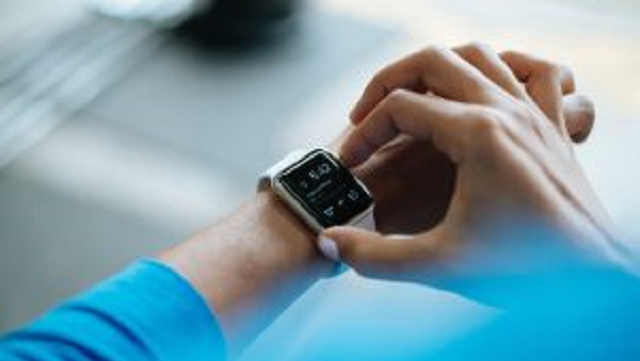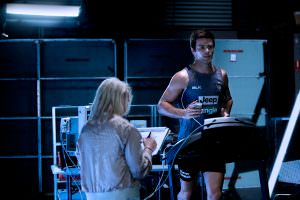You’re probably already pretty comfortable with wearing your technology. But how will you feel about implanting or ingesting it?
Learn about how advancements in technology have translated to wearable tech, both on and in the body – combining technology and science to improve people’s lives in this resource for students in Years 5, 7, 8, 9 and 10.
Word count: 1481

Tapping away at a screen or keyboard is so last year! What would you think if I said you could achieve the same results by stroking your tattoo, snapping your fingers or even just sleeping?
Whether you want to climb mountains, pay for coffee, visit your doctor – or you’re a gamer using flamethrowers and chainsaws to destroy mutant creatures in derelict mansions – there’s something wearable, implantable or ingestible to help you do it.
Wearables are blasting into everything from health and fashion to gaming and sport, so whatever you’re in to there’s bound to be a team of creative people developing cool and tiny tech to help you do it.
Here’s what’s happening, and how to be part of it.
Where wearables are at
There was a time when computers were the size of houses – seriously. Now you can strap them on your wrist, inject them under your skin or wear them as an outfit.
From wedding rings to contact lenses, the stuff we wear can now be integrated digitally and intimately with the things we do. Our relationship with data and technology is changing, and so is the way we live.
“The current major focus is on wrist-worn wearables, such as the Fitbit, and making smart watches more useful,” says Professor Bruce Thomas, who heads up the University of South Australia’s Wearable Computer Lab. “This is only the tip of the iceberg.”
Prof Thomas works at the frontier of wearable evolution, where he says there are awesome job opportunities. “If you don’t have a passion for what you’re doing in life, go find one,” he advises. “The major areas for wearables are electronics, user interfaces and application development. This requires skills in computer science, electrical engineering and design.
“This is very fun! You could be making a whole new way to interact with the data all around you.”
Something new to wear
By weaving fabrics from conductive thread, you can embed electronics into an outfit. This thread looks and behaves like ordinary sewing thread except that it can carry a current, meaning it can be used instead of wires in devices sewn into clothes. The thread is stocked by specialist electronics suppliers but any keen dressmaker would be able to use it.
Google is teaming up with jeans manufacturer Levi’s to create jackets that allow you to answer your phone or operate your TV, all with the touch of your sleeve. Researchers are even working on fabrics that filter out embarrassing odours, moisturise your skin or store the energy you generate when you move.

In another e-clothing application, you can feel what a footy player feels by wearing the ultimate fan tee: Alert Shirt. This shirt feeds live sports data into its smart fabric, giving its wearer a real feel for the on-field action. (Image courtesy of WearableX.com)
And if you’re really into gaming you probably know that virtual reality headsets like Google Glass and Oculus Rift are already being combined with smart fabrics.
In the same ‘smartglasses’ space as Google Glass – which to be honest hasn’t really set the world on fire – comes Snapchat Spectacles, a possible alternative that might do a little better in the marketplace. The camera built into Snapchat’s ‘Spectacles’ lets you shoot video that shows the world from your point of view. They record video, can be paired to your phone and come from the same people behind the Snapchat social media app.
Tattoos meet technology
It’s Art. It’s technology. It’s computer chips embedded beneath the skin, injected micro-particles and implantable skin mesh. And not so long ago it was all still science fiction but now it’s reality. In one form, technology and tattoos merge in devices known as ‘tech tats’.
These are made with conductive paint and other components that can be incorporated into a circuit so that they are able to collect and store data. They can monitor your body, dial your phone or unlock your car, and all with just the wave of a hand.
Helmet Help
Every hour that an aeroplane is grounded costs $12,000. To return planes to the air faster, scientists at Australia’s national researcher, CSIRO, have developed smart helmet technology called Guardian Mentor Remote (GMR).
By wearing it you can link to a remote expert in real-time, share what you’re seeing, get the right advice, and repair a problem on the spot. The same tech can be used for medical emergencies, car breakdowns and even assembling IKEA furniture.
UNSW’s Prof Julien Epps predicts that this kind of tech is going to be huge. “Strap a webcam to your forehead, connect to an expert, and be guided through,” he says. “Remote ‘teleassistance’ is already possible… Soon everyone will be sharing what they’re doing with experts around the world.”
The bionic rock climber
“I don’t see disability, I see bad technology.” That’s Hugh Herr’s perspective on the world. Hugh, who’s also known as Bionic Man, is a biomechatronics researcher and elite rock climber.
At 17 he lost both legs in an ice climbing accident. Some people viewed his body as ‘broken,’ but Hugh saw only busted technology, so he set out to fix it.
First, he made himself a pair of prosthetic legs with pointed feet, so he could climb even faster than before. Then he decided to study maths and robotics at uni.
Today he’s the inventor of BiOM: robotic legs that integrate with the human body to mimic the function of missing muscles and tendons. Thanks to Hugh’s invention, amputees can run, climb and dance again.
The next big thing?
Prof Ingrid Richardson gets paid to play games and watch cat videos. She was an Associate Professor in Digital Media at Murdoch University, and is now Professor of Digital Media at RMIT University, and studies the way new technologies are impacting our lives.
“We’re seeing new modes of communication. We’re seeing changes in the way we interact,” Prof Richardson says. “Every space we experience is now informed by an additional informational layer.”
Her advice for anyone wanting to invent their own wearable technology is to remember who’s wearing it: think beyond what is possible and target what is popular.
“The way people take up technology is often unintended by designers of technology,” Prof Richardson explains. “New technologies have to be able to fit into people’s lives, so look at the history of the way people take up technology. Think critically about your own life, how you and your family use technology, what you like about it, what you don’t like. Then put that in the broader context of society’s use.”
Prof Richardson’s tip for the next big thing in wearables? Augmented reality, which is where computer-generated images integrate with what’s going on in the real world. “People seem much more comfortable with augmented reality than virtual reality, because they can integrate it into their everyday lives,” she explains. “It’s an avenue that’s really starting to take off, like we’re seeing with the huge uptake of Pokémon Go and other mobile apps.”
Feeling frisky?
Want to know what Coco your cat gets up to at night? Concerned about Bluey’s fitness? You’re not alone. Wearable pet tech is already worth more than $2.6 billion a year worldwide. “People use it as a way of understanding their pet’s behaviour and issues,” Prof Richardson says. “You can put cameras and GPS onto pets to experience what they experience.”
You can also monitor their heart rate, track their sleeping patterns or even measure their ‘friskiness’. And check out the MooMonitor+, a cow-wearable that lets farmers know when their cows are keen to breed.
Wearable Body Parts
Of course, the ultimate wearables are replacements for worn out, diseased or faulty body parts. Perhaps the most famous so far is the incredible cochlear implant – also known as the bionic ear – an implantable device that more than 300,000 people now use every day to help them hear. Then, of course, there’s been much talk about work on a bionic eye, which is said to soon be coming our way.
But already closer to reality is the ‘wearable kidney’. Currently artificial kidneys, also known as hemodialysis machines, look like antique versions of R2-D2 although for patients with dodgy kidneys they’re lifesaving technology. Unfortunately, they’re also a time-consuming hassle. Patients can spend hours each day sitting around hooked up to their artificial kidney, waiting for it to filter waste products from their blood.
Now inventors have created a wearable artificial kidney. It’s small enough to be carried around but advanced enough to do the job. Human trials are already underway, with users reporting great quality of life and fewer hospital visits.
Skill up
To join the wearable revolution you could study electrical engineering, industrial design, biomedical engineering, mechanical engineering, computer engineering and more. Ask at your local university.
Login or Sign up for FREE to download a copy of the full teacher resource





